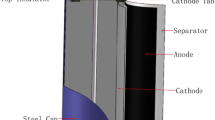Abstract
Olivine LiFePO4 is challenged by its poor electronic and ionic conductivities for lithium-ion batteries. Polyethylene glycol (PEG) has been applied for LiFePO4 preparation by different research groups, but there is no consensus on the influence of the mean molecular weight of PEG on the structure and electrochemical performances of LiFePO4/C composites. In this work, LiFePO4/C composites were prepared by using micronsized FePO4·2H2O powder as starting material, PEG (mean molecular weight of 200, 400, 4000 or 10000) and citric acid as complex carbon source. The structure and electrochemical performances of LiFePO4/C composites would be decided considerably by the mean molecular weight of PEG, and the sample using PEG200 exhibited the least inter-particle agglomeration, the smallest charge transfer resistance and the highest discharge capacity. A probable growth mechanism is also proposed based on SEM images and electrochemical results: with the assistance of citric acid, PEG molecule with small molecular weight tends to cover one or only a few micron-sized FePO4·2H2O particles, significantly suppress the agglomeration of primary LiFePO4 particles and thus result in uniform particle-size distribution and carbon coating.
Similar content being viewed by others
References
Franger, S., Le Cras, F., Bourbon, C., and Rouault, H., Electrochem. Solid-State Lett., 2002, vol. 5, no. 10, pp. A231–A233.
Zhou, G.F., Russ. J. Appl. Chem+., 2017, vol. 90, no. 9, pp. 1519–1523.
Eftekhari, A., J. Power Sources, 2017, vol. 343, pp. 395–411.
Li, X.F., Luo, D.M., Zhang, X., and Zhang, Z., J. Power Sources, 2015, vol. 291, pp. 75–84.
Mat, A., Sulaiman, K.S., and Arof, A.K., Ionics, 2016, vol. 22, no. 1, pp. 135–142.
Kuzmanovic, M., Jugovic, D., and Mitric, M., et al., Ceram. Int., 2015, vol. 41, no. 5, pp. 6753–6758.
Xia, J., Zhu, F.L., and Wang, G.R., et al., Solid State Ionics, 2017, vol. 308, no. 1, pp. 133–138.
Wang, P., Zhang, G., and Li, Z.C., et al., Acs Appl. Mater. Inter., 2016, vol. 8, no. 40, pp. 26908–26915.
Liu, S.X., Yin, H.B., Wang, H.B., and Wang, H., J. Nanosci. Nanotechno., 2014, vol. 14, no. 9, pp. 7060–7065.
Wang, Y.H., Mei, R., and Yang, X.M., Ceram. Int., 2014, vol. 40, no. 6, pp. 8439–8444.
Zhi, X.K., Liang, G.C., and Ou, X.Q., et al., J. Electrochem. Soc., 2017, vol. 164, no. 6, pp. A1285–A1290.
Wang, L.N., Zhan, X.C., Zhang, Z.G., and Zhang, K.L., J. Alloy. Compd., 2008, vol. 456, no. 1, pp. 461–465.
Qiu, S., Zhang, X.G., and Li, Y.W., et al., J. Mater. Sci.-Mater. El., 2016, vol. 27, no. 7, pp. 7255–7264.
Li, X.T., Shao, Z.B., and Liu, K.R., et al., Colloid Surface A, 2017, vol. 529, pp. 850–855.
Wang, F., Fang, Z.W., and Zhang, Y., J. Electroanal. Chem., 2016, vol. 775, pp. 110–115.
Yang, X.H., Tu, J.G., and Lei, M., et al., Electrochim. Acta, 2016, vol. 193, pp. 206–215.
Tan, L.Y., Tang, Q.L., and Chen, X.H., et al., Electrochim. Acta, 2014, vol. 137, no.8, pp. 344–351.
Zhu, J.X., Yoo, K., El-halees, I., and Kisailus, D., Acs. Appl. Mater. Inter., 2014, vol. 6, no. 23, pp. 21550–21557.
Hong, J.H., Wang, Y.F., He, G., and He, M.Z., Mater. Chem. Phys., 2012, vol. 133, no. 1, pp. 573–577.
Liu, H., Cao, Q., and Fu, L.J., et al., Electrochem. Commun., 2006, vol. 8, no. 10, pp. 1553–1557.
Wang, J. and Sun, X., Energy Environ. Sci., 2015, vol. 8, no. 4, pp. 1110–1138.
Bazzi, K., Nazri, M., and Naik, V.M., et al., J. Power Sources, 2016, vol. 306, pp. 17–23.
Zhang, N., Lin, L., and Xu, Z., J. Solid State Electrochem., 2014, vol. 18, no. 9, pp. 2401–2410.
Author information
Authors and Affiliations
Corresponding author
Additional information
The text was submitted by the author in English.
Rights and permissions
About this article
Cite this article
Hong, J., Yin, G. Polyethylene Glycol for LiFePO4/C Composites Preparation: Large or Small Molecular Weight. Russ J Appl Chem 91, 1612–1616 (2018). https://doi.org/10.1134/S1070427218100075
Received:
Published:
Issue Date:
DOI: https://doi.org/10.1134/S1070427218100075




